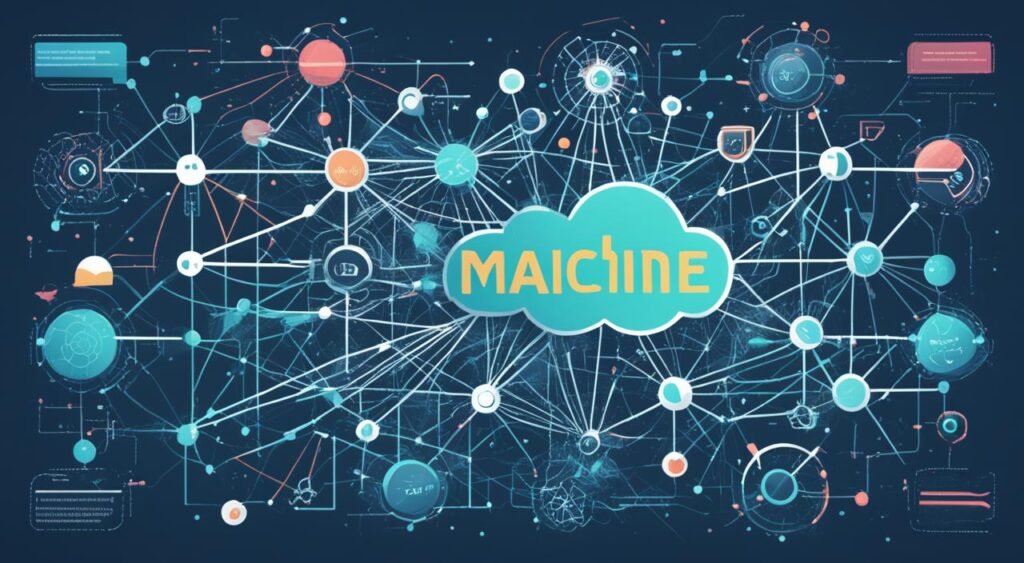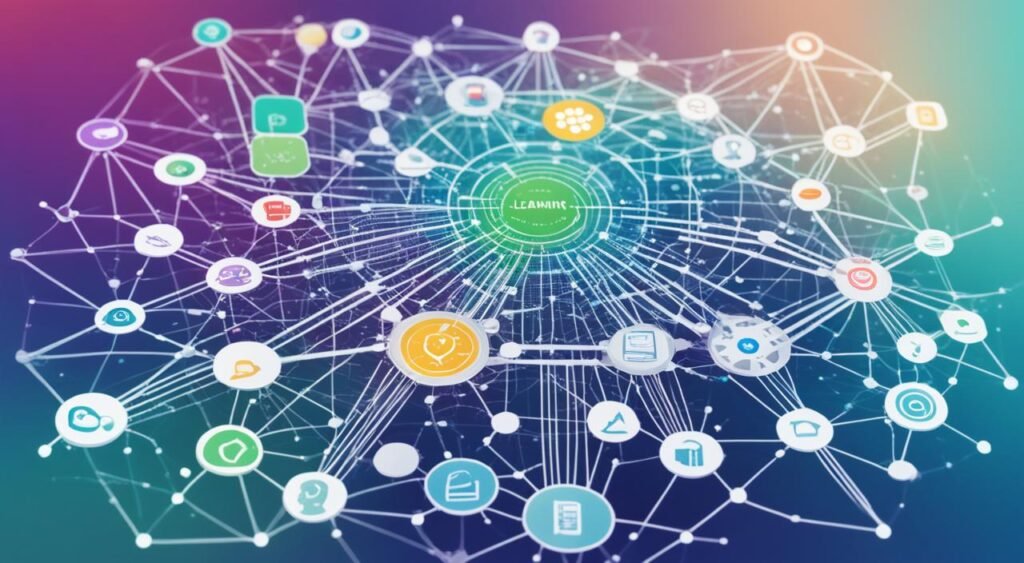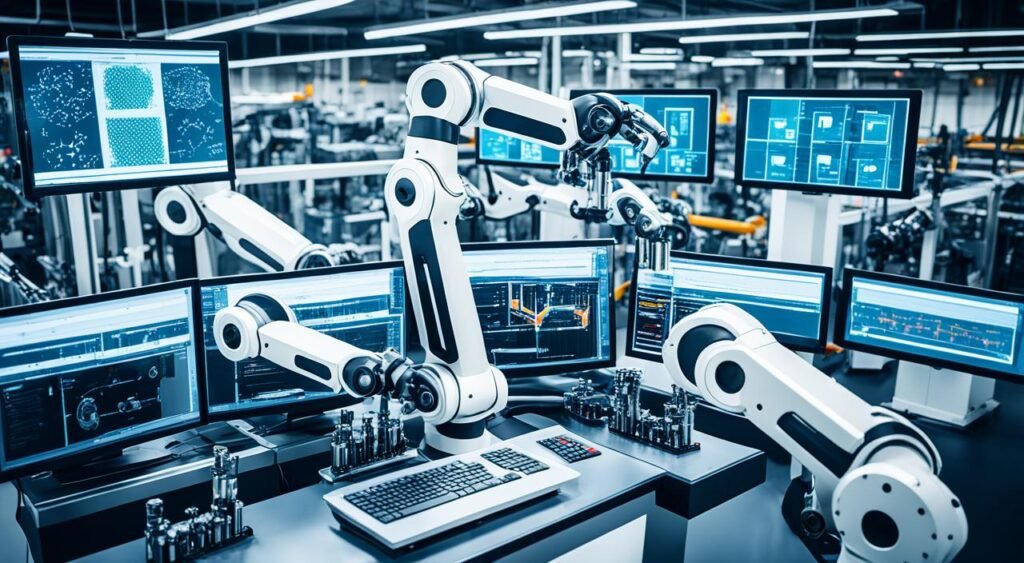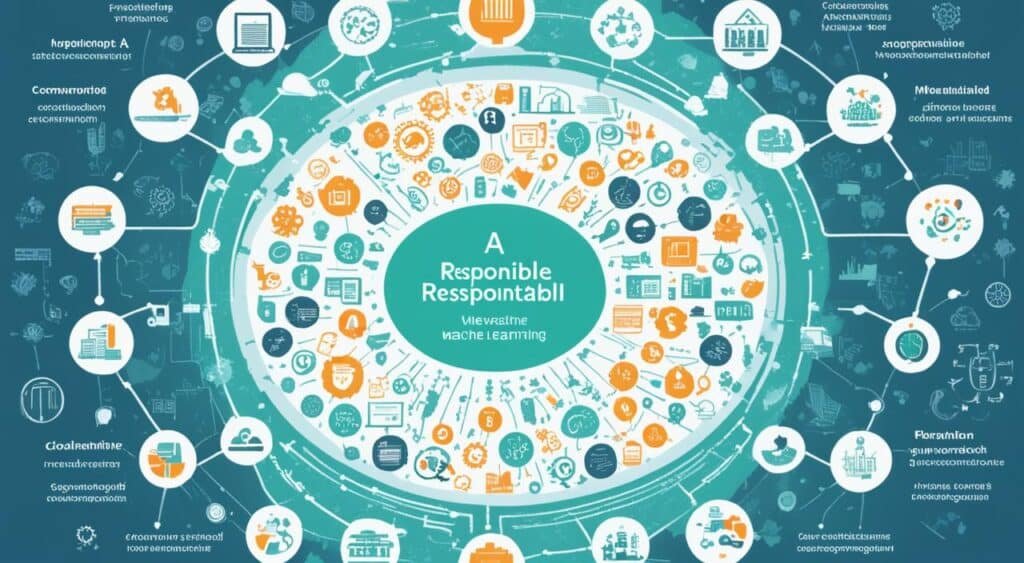Machine learning is about making AI systems learn and evolve from data. It uses algorithms and models to learn tasks, like humans do. This field is a crucial part of AI and computer science.
The main types are supervised, unsupervised, and reinforcement learning. Supervised learning teaches algorithms with labeled data to classify or predict accurately. In contrast, unsupervised learning finds patterns in data without labels. And reinforcement learning learns through interaction and feedback.
ML powers tech we often use, from chatbots to autonomous vehicles. It helps us communicate better with machines and has a big influence across many areas. As ML and AI grow, their impact on various sectors increases too.
Key Takeaways
- Machine learning is a subfield of artificial intelligence that enables systems to learn and improve from data without being explicitly programmed.
- The three main types of machine learning are supervised learning, unsupervised learning, and reinforcement learning.
- Supervised learning uses labeled datasets to train algorithms to classify data or predict outcomes accurately.
- Unsupervised learning analyzes and clusters unlabeled datasets using machine learning algorithms.
- Reinforcement learning learns through trial and error, rather than being trained on sample data.
- Machine learning is behind many everyday technologies, from chatbots to autonomous vehicles.
- As AI and machine learning advance, these technologies are becoming increasingly prevalent across industries.
Introduction to Machine Learning
Machine learning is a thrilling part of artificial intelligence (AI). It focuses on using algorithms that learn from data. These algorithms can find patterns and make predictions without direct instructions. This area has changed how we solve problems, analyze data, and make decisions across many fields.
Definition and History of Machine Learning
Arthur Samuel, an IBM worker, started the term “machine learning” in 1959. He’s a pioneer in computer games and AI. Even though it officially began in the 50s, the ideas go back to work on human thought processes. People like Donald Hebb, Walter Pitts, and Warren McCulloch set the stage. They’re known for their early work on machine learning techniques.
Machine Learning as a Subfield of Artificial Intelligence
Artificial intelligence (AI) aims to create computer models with human-like smartness. Machine learning is one way to get there. It uses statistical algorithms to learn from data. This is different from AI methods that use step-by-step instructions. Machine learning helps AI models be more flexible, work on their own, and tackle tough problems.
Machine learning and AI together have led to huge improvements. We see these in areas like understanding language and seeing images. These developments make predictive analytics and decision-making better too. As tech gets better, machine learning and AI will keep growing. This means more ways to make progress and change different industries.
“Machine learning is the field of study that gives computers the ability to learn without being explicitly programmed.” – Arthur Samuel
Supervised Machine Learning
Supervised learning is a key part of supervised machine learning, making it great for solving real-world issues. It uses labeled datasets to teach algorithms. This way, the algorithms can classify data or predict results well.
The method starts by giving data to a model. The model adjusts its internal parts or “weights” to fit the data well during cross-validation. Then, the model can rightly predict or classify new data.
Here are some common supervised learning algorithms:
- Neural networks
- Naive Bayes
- Linear regression
- Logistic regression
- Random forest
- Support vector machine (SVM)
These algorithms are very useful in many areas, like telling good emails from spam or making predictions. They help organizations tackle big issues and make choices based on data, leading to business wins.
“Supervised learning is a powerful tool for unlocking the insights hidden within your data, allowing you to make informed decisions and drive real-world impact.”
As machine learning keeps improving, supervised learning algorithms will become even more important. They are crucial for any organization that wants to use data effectively.
Unsupervised Machine Learning

Unsupervised machine learning lets algorithms learn from unlabeled data. This means they can find hidden patterns on their own. It’s great for many things like analyzing data trends, finding new customer groups, and recognizing images.
Clustering Algorithms
Clustering is a key task for unsupervised learning. It helps group similar things together. This is useful for spotting customer segments or making sense of complicated data sets.
Dimensionality Reduction Techniques
Another key use is reducing the complexity of data with dimensionality reduction. Techniques like PCA help simplify high-dimensional data. This makes it easier and faster to work with large data sets.
There are also neural networks and probabilistic models for unsupervised learning. These are used to learn patterns and group data based on their likely distributions.
“Unsupervised learning is a crucial component of the machine learning landscape, enabling organizations to unlock hidden insights and streamline their decision-making processes.”
| Unsupervised Learning Algorithm | Use Case |
|---|---|
| K-Means Clustering | Customer segmentation, image recognition |
| Hierarchical Clustering | Market basket analysis, anomaly detection |
| Principal Component Analysis (PCA) | Dimensionality reduction, feature extraction |
| Gaussian Mixture Models | Anomaly detection, document clustering |
Machine Learning Algorithms

The realm of machine learning is broad, filled with various algorithms for different tasks. These range from complex neural networks to simple decision trees. They change how we solve big problems.
Neural Networks
Neural networks copy the human brain’s structure and functions. They’re made of nodes or neurons that work together. They’re best at tasks like understanding human languages, recognizing images, and identifying voices. They play a key role in artificial intelligence.
Decision Trees and Random Forests
Decision trees offer a clear way to understand machine learning. They use a series of decisions shaped like a tree. This makes them easy to check and understand. Random forests make predictions better by using many decision trees together.
There are also other important algorithms in machine learning, including linear and logistic regression. Each has its unique uses. The right algorithm depends on the problem, data, and goals.
| Algorithm | Description | Applications |
|---|---|---|
| Neural Networks | Inspired by the human brain, neural networks consist of interconnected processing nodes that learn to recognize patterns and make predictions. | Natural language processing, image recognition, speech recognition |
| Decision Trees | These algorithms use a branching sequence of linked decisions to make predictions, with the advantage of being easily interpretable and auditable. | Classification, regression, and decision-making tasks |
| Random Forests | Random forests combine the results of multiple decision trees to enhance the accuracy and robustness of the predictions. | Classification, regression, and feature importance identification |
Machine learning algorithms are always getting better, thanks to ongoing research and practice. By knowing what these algorithms can do, we can use machine learning to tackle big problems and spur innovation in many fields.
Deep Learning and Neural Networks

Deep learning is a part of machine learning that’s very effective in solving complex problems. It uses artificial neural networks, inspired by the human brain. This lets machines learn from big amounts of complex data.
These networks can analyze and learn from data by themselves. They don’t need humans to tell them what’s important, known as feature engineering. This makes them great at finding patterns in tasks like telling what’s in an image, understanding language, and recognizing speech.
A big plus of deep learning is its power to work with lots of data. It can process huge amounts of information to find new insights. This helps in making better choices in many areas, such as in identifying pictures, translating languages, and finding new medicine.
Deep learning can do more than just see pictures and understand words. It’s also used to make machines learn how to behave in different situations. This has led to advances in playing games, running robots, and making wise decisions.
The future of deep learning looks very promising. It could lead to big changes in things like driving cars without people, or making healthcare more tailored to individual needs. Deep neural networks are on the path to change the world we know.
| Characteristic | Description |
|---|---|
| Architecture | Deep neural networks consist of multiple hidden layers, allowing for hierarchical feature extraction and learning. |
| Data Requirement | Deep learning models thrive on large, diverse datasets, often requiring more data than traditional machine learning approaches. |
| Automation | Deep neural networks can automatically learn features and patterns from data, reducing the need for manual feature engineering. |
| Performance | Deep learning models have demonstrated superior performance in a wide range of tasks, often outperforming traditional machine learning techniques. |
The boundless potential of deep learning is still being uncovered. It is changing many industries and how we use technology. This impact will continue to be felt in the advancement of artificial intelligence.
“Deep learning has the potential to transform entire industries, from healthcare to transportation, and will continue to be a driving force in the future of artificial intelligence.”
Applications of Machine Learning

Machine learning is a powerful tech with wide applications in many fields. It is especially impactful in understanding human languages and processing images.
Natural Language Processing
Machine learning in natural language processing lets computers talk like humans. It created chatbots, digital helpers, and translation apps. These systems understand conversations, contexts, and feelings, breaking language barriers.
Computer Vision and Image Recognition
In computer vision, machine learning makes sense of pictures and videos. It can spot objects, faces, and understand scenes. Such technology is crucial for self-driving cars, medical checks, and security.
Machine learning is changing many industries. It automates work, finds new insights, and predicts outcomes. It works in fraud prevention, giving recommendations, and driving cars without help. Its possibilities are endless and impact all of us.
| Machine Learning Application | Description |
|---|---|
| Natural Language Processing | Enables machines to understand, interpret, and generate human language, powering technologies like chatbots and language translation apps. |
| Computer Vision and Image Recognition | Allows machines to analyze and make sense of digital images and videos, enabling tasks like object classification and facial recognition. |
| Predictive Analytics | Uses machine learning to uncover patterns and make predictions that can inform strategic decision-making. |
| Fraud Detection | Leverages machine learning algorithms to identify and prevent fraudulent activities in real-time. |
| Recommendation Systems | Employs machine learning to provide personalized product or content recommendations to users, enhancing their experience. |
| Autonomous Vehicles | Relies on machine learning to enable self-driving vehicles to navigate and make decisions in complex environments. |
Machine learning’s growth continues. Its future impact is hard to predict but promises big changes. It will shape how we live and work in ways we’re just starting to see.
Machine Learning in Business and Industry

Machine learning is changing how we do business. It uses data to predict future trends and offer customized solutions. This makes operations more efficient and valuable in many fields.
In a 2020 Deloitte survey, 67% of businesses said they’re using machine learning. 97% plan to use it in the coming year. This shows its huge potential to innovate and succeed in various industries.
Unlocking the Power of Predictive Analytics
Predictive analytics is a key benefit of machine learning. It lets businesses make decisions based on future trends. For example, it helps manufacturers avoid expensive machine breakdowns. It also allows online retailers to suggest products customers are likely to buy, enhancing sales and loyalty.
Transforming Industries with Machine Learning
Machine learning isn’t just for some industries; it’s changing many. It’s being used in banking to spot fraud and in healthcare to improve medical images and find new drugs. Its reach is vast, helping with tasks that were once seen as impossible.
| Industry | Machine Learning Applications |
|---|---|
| Manufacturing | Predictive maintenance, quality control, supply chain optimization |
| Retail | Personalized recommendations, demand forecasting, inventory optimization |
| Banking | Fraud detection, credit risk assessment, customer segmentation |
| Healthcare | Medical imaging analysis, drug discovery, patient risk prediction |
As machine learning gets smarter and more common, its effects will be broader. Businesses must see the value in this technology to keep up. They need to use it well and ethically to improve their strategies.
“Machine learning is changing every industry, and business leaders need to understand its potential as well as its limitations in order to use it effectively and responsibly.”
Also Read : What’s The Impact Of 5G Technology On Healthcare?
Ethical Considerations in Machine Learning

Machine learning is growing fast. We need to think about its ethical side. This tech can make our lives better. But, it also brings up serious concerns that we must deal with.
Bias is a big problem in machine learning. If the data we feed these systems is biased, they learn that bias. Then, they might make unfair choices. For example, someone might not get a job just because of their background. Fixing this bias is a big challenge. It asks for everyone to work on it together.
Privacy and data rights are also at risk. Machine learning needs a lot of data to work well. This can raise privacy issues. Making sure user data is safe is key to keeping people’s trust.
The effect on jobs is another big issue. Some worry that machines will take over jobs. Making sure this change is fair is important. Everyone, from businesses to policy makers, must join hands to protect workers.
Dealing with these ethics needs a team effort. People, policy makers, and experts must work together. This way, we can steer machine learning in a positive direction for all.
“The development of full artificial intelligence could spell the end of the human race.”
– Stephen Hawking
Considering ethics in machine learning is crucial. It helps us use this tech for everyone’s benefit safely.
Conclusion
Machine learning is a big part of artificial intelligence. It’s making big changes in many fields. It is found in things we use every day like understanding our language, seeing things clearly, and making predictions. It’s important for everyone, not just experts, to know what it can and cannot do, and its impact on the world.
This article covered the basics of machine learning. We talked about how it has grown over time. It’s closely linked with artificial intelligence. Different types of algorithms make it work. Knowing these basics helps us see the big possibilities of machine learning.
But, we must also think about its effects on our lives. Things like being unfair, keeping our data safe, and using AI in a good way are important. As machine learning gets more common, we need strong rules. These rules should make sure machine learning helps society in a positive way.
FAQs
What are the main types of machine learning?
The main types include supervised, unsupervised, and reinforcement learning. Supervised learning relies on labeled data for training. Unsupervised learning groups data without labels. Reinforcement learning learns by making mistakes.
What is the definition and history of machine learning?
Machine learning is about training computers to learn from data. This way, they can improve their performance over time. The term was first used in 1959 by Arthur Samuel of IBM. He was a pioneer in computer gaming and AI.
How is machine learning related to artificial intelligence?
Machine learning is part of a bigger field called artificial intelligence. It works on making computers act intelligently. AI includes everything around making machines smart. Machine learning specifically teaches systems to learn from data.
What are the key supervised learning algorithms?
Supervised learning has several key algorithms. These include neural networks, naive bayes, and linear and logistic regressions. There are also random forests and support vector machines.
What are the key unsupervised learning algorithms and techniques?
The main unsupervised learning methods are neural networks, k-means, and probabilistic clustering. Techniques like PCA and SVD are also used. These help find patterns in unlabeled data.
What are some of the most important machine learning algorithms?
Some common algorithms are decision trees, random forests, and linear and logistic regressions. Others include support vector machines. Each serves a different purpose in making predictions from data.
What is deep learning and how does it differ from other machine learning?
Deep learning is within machine learning. It uses deep neural networks to process a lot of complex data. Unlike other methods, deep learning doesn’t need humans to pick the right features from the data.
What are the key applications of machine learning?
Machine learning is behind many things we use, like voice assistants and self-driving cars. It’s also used in fraud detection and choosing what movies to watch online. This is through methods like predictive analytics and computer vision.
How is machine learning being used in business and industry?
Companies use machine learning to get an edge. It helps with things like predicting when machines need fixing, or showing customers products they might like. It also spots fraud more easily.
What are the ethical considerations around machine learning?
Machine learning needs to be fair and secure. It can sometimes make mistakes or invade privacy. Using it responsibly is important for everyone’s safety and jobs. So, we need to be careful with how we create and use these systems.
